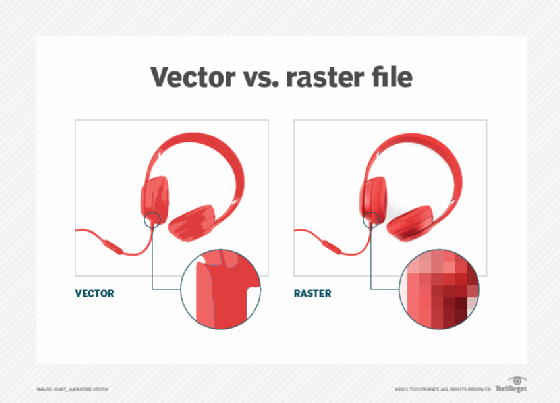
- #VECTOR VS. RASTER FILE FORMATS PDF#
- #VECTOR VS. RASTER FILE FORMATS FULL#
- #VECTOR VS. RASTER FILE FORMATS PORTABLE#
- #VECTOR VS. RASTER FILE FORMATS SOFTWARE#
BMP files are commonly used with Windows. A bitmap file uses an array of dots called pixels to represent images. Bitmaps store two-dimensional images and can be viewed on a screen independent of a graphics processor. BMPīMP is the abbreviation for bitmap file.
#VECTOR VS. RASTER FILE FORMATS PDF#
They are usually large format files and though they’re used today, TIFs have mostly been superseded by the more modern PDF format since the early 2000s. TIFF is the main file format used for storing image matrixes, and is mostly used for printing. TIF format stands for Tagged Image File format. Great addition is the availability of a transparent background in this format. If you need to reduce the size of an image without too much quality loss, PNG can serve as a good choice. PNG files help in storing photos and images with continuous tones, and are more compressed than JPGs.
#VECTOR VS. RASTER FILE FORMATS PORTABLE#
PNG stands for Portable Network Graphics Files. PNG files are used to store images in a clear format.
#VECTOR VS. RASTER FILE FORMATS FULL#
GIFs don’t support the full range of colors, like JPG format, so this format isn’t best for saving photos. This file type was developed by CompuServe back in 1987 and you will find these file types as graphics on websites and web applications, especially in animated images, banners and buttons. GIF stands for Graphics Interchange Format, and is a bitmap (meaning that the image consists of pixels). JPG is one of two formats of graphic images (along with GIF) that you will find most commonly used on the internet. Most photos you see displayed on websites are likely to be a JPG file. JPG files support a full 24-bit palette of colors, so these are the best file type to use for photos. They are examples of bitmap images and typically smaller in size than their counterpart, the PNG image. JPG (or JPEG) files store graphical images. Here’s a list of the most popular raster image formats used, along with an explanation of each. To know more in-depth information about each type, and when to use them, you can read the article on the most widely used vector formats. Most common vector file formats include the following: Finally, Portable Document Format (PDF), while mainly used as a document format, often holds vector as well as raster elements and is highly versatile, making it perfect for digital printing purposes. An example of these formats is Photoshop Document (PSD) which is used by Adobe Photoshop other less commonly used formats include PSP (Corel Paint Shop Pro) and XCF (Gimp). Their layers can be switched on and off, allowing for visibility or editing of certain elements of an entire composition. Sometimes you may come across popular raster graphic formats that contain more than a simple image.
#VECTOR VS. RASTER FILE FORMATS SOFTWARE#
It's also worth noting that many popular graphic design software tools like Adobe Illustrator, Photoshop can handle both raster and vector graphics. Popular vector graphic file formats include SVG, AI, PDF and EPS. The most popular raster graphic file formats include JPEG, PNG, and GIF. This is another reason some service providers will request vector files, as vector images are more compressed and thus easier to transfer and store. The higher the pixels per inch (PPI) or dots per inch (DPI), the higher the clarity, but the file will be larger and will take up more storage space. Raster graphics, because they are made of pixels, can amount to quite a large file size. While raster graphics are best for photographs and other types of images with continuous tones, when working with illustrations and graphics with clean lines and shapes, it’s best to use vector graphics. Raster graphics only retain quality if they are scaled down, but when a raster graphic is enlarged it becomes pixelated, and can look grainy or less clear. This makes vector files incredibly versatile, as a small image viewed on your screen can be scaled to the size of a billboard and remain just as clear. The main practical difference in the two types is that vector graphics can be scaled without any loss of quality. Vector graphics are made up of curves that form paths and shapes, defined by mathematical equations.

Raster graphics are also known as bitmap graphics, and are made of thousands of tiny pixels arranged in a grid to form an image.


 0 kommentar(er)
0 kommentar(er)
